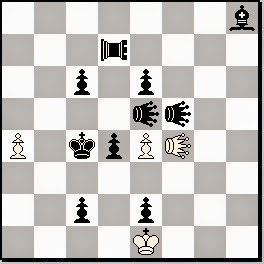Lion : Is a hurdle jumper, moves at Queen lines, jumps over a hurdle and steps on one of the empty squares (or captures a piece there) which are exactly behind the hurdle.
The "hurdle-color changing" Lion (or Andernach Lion) when passes over a hurdle changes the color of the hurdle (except it is a King or a neutral piece).
Last year we had seen, among the awarded problems in the World Congress on Chess Composition (WCCC) in Bern, the following problem with one Andernach Lion.
The composition tourney asked from the composers a helpmate two-mover with hurdle-color changing Lions. We had two ideas but the deadline was only three hours, so we barely had the time for checking one composition, the problem-776.
The composition tourney asked from the composers a helpmate two-mover with hurdle-color changing Lions. We had two ideas but the deadline was only three hours, so we barely had the time for checking one composition, the problem-776.
| Problem-776 Manolas Emmanuel (GRE) and Prentos Kostas (GRE) Commendation, Quick Composing Ty, WCCC 2014 Bern |
|
2Sk4/3p4/8/3K4/8/8/1(whL)2r3/8 (3 + 3) (hL hurdle-color changing Lion b2 + 0) h#2, two solutions |
| 1.Re2-f2 hLb2-g2(wRf2) 2.Kd8-e8 hLg2-a8# 1.Re2-e5+ hLb2-g7(wRe5) 2.Kd8xc8 Re5-e8# |
The Judge wrote : "Nice miniature. The white rook and Lion exchange functions in the mate". |
The second idea lead us to the Problem-795. The idea here was to put the black Lions as epaulets from both sides of the mating piece, so they cannot capture it. This is achieved with Orthogonal - Diagonal Transformation, as you can see in the solution.
The prominent composer Kostas Prentos, international maitre and multi-champion of Greece in solving contests, has moved to Uinted States of America, that is why his name is appended with USA.
| Problem-795 Prentos Kostas (USA) and Manolas Emmanuel (GRE) Julia's Fairies No.593, 04-09-2014 |
|
8/8/(whL)5b1/2(bhL)p4/3pk3/1K6/1(bhL)P1r3/8 (3 + 7) (hL, Andernach Lion a6 + b2 c5) h#2, a) Diagram, b) wPc2 to g2 |
| a) 1.hLc5-f2(wPd4) Kb3-c3 2.hLb2-d2(bPc2) hLa6-f1(wRe2)# b) 1.hLc5-g5(wPd5) Rb3-c4 2.hLb2-g7(wPd4) hLa6-h6(wBg6)# |
For this problem we had many comments, mainly because the black pieces bRe2 and bBg6 stayed inert, waiting to change color. It is not forbidden for black pieces to stay inactive in some of the solutions (for white pieces this is forbidden), nevertheless the composition could be altered. |
The composer Ladislav Packa had proposed to us the idea to convert the inactive pieces to Andernach Lions. In the following Problem-796, besides Lions (moving in Queen lines) we use a Rook-Lion (moving in Rook lines). To achieve what we want, we start with a white move, so the problem is now h#2,5 .
| Problem-796 Packa Ladislav and Prentos Kostas and Manolas Emmanuel Pat a Mat No.90, December 2014, page 242 Problem No.790 |
|
7b/3(bhRL)4/2p1p3/4(bhL)(bhL)2/P1kpP(whL)2/8/2p1p3/4K3 (4 + 10) (hL, Andernach Lion f4 + e5 f5) (hRL, Andernach Rook-Lion 0 + d7) h#2.5, two solutions |
| 1…hLf4-c7(whLe5)+ 2.hRLd7-b7(bhLc7) Ke1xe2 3.hLf5-d7(wPe6) hLe5-b8(whLc7)# 1…hLf4-f7(whLf5)+ 2.hRLd7-g7(bhLf7) Ke1-d2 3.hLe5-e7(wPe6) hLf5-f8(whLf7)# |
Here there is Orthogonal - Diagonal Transformation and the idea of Lions as epaulets is well presented. |
Since the moves have become 2.5, the question arises if we can make something different for helpmate twomover. I have tried the position which is shown as Problem-797.
| Problem-797 Manolas Emmanuel (GRE) original |
|
3K1(whL)2/8/8/2SP2(bhL)1/3k4/1P6/5br1/1s4B1 (6 + 5) (Andernach Lion f8 + g5) h#2, a) Diagram, b) bRg2 to b4 |
| a) 1.hLg5xg1(wRg2) Rg2-g5 2.hLg1-a1(wSb1) hLf8-f1(wBf2)# b) 1.hLg5xc5(bPd5) Bg1-h2 2.hLc5-e3 hLf8-a3(wRb4)# |
Here we see the Orthogonal - Diagonal Transformation, but not the epaulets, which may be abandoned. Black pieces are used that stay inactive in some phase (not forbidden, but not economical enough), and the solutions have not the same number of color changing. |
Maybe I can do better. Let us try a new position.
| Problem-798 Manolas Emmanuel (GRE) original |
|
8/8/8/1(bhL)pk4/p7/4Kp2/1P2(bhL)1(bhL)1/8 (2 + 7) (hL Andernach Lion 0 + b5 e2 g2) h#2, a) diagram, b) bPa4 to e6 |
| a) 1.hLg2-c2(whLe2) b2-b4 2.hLc2-c6(wPc5) hLe2-a6(whLb5)# b) 1.hLb5-f1(whLe2) b2-b3 2.hLf1-f4(wPf3) hLe2-h2(whLg2)# |
Here White has minimal force, just one Pawn, but he can find the required forces to make two mates, one in an orthogonal way and one in a diagonal way. In each solution there are three changes of color. |
Can this become better? The answer is yes.
| Problem-799 Manolas Emmanuel (GRE) and Prentos Kostas (GRE) dedicated to Ladislav Packa The Problemist vol.25 No.1, January 2015, problem F3184 Commendation, vol.27 No.6, November 2019, p.242 |
|
4K3/8/8/1(bhL)pk1p2/p2p4/5p1(whL)/1p2(bhL)1(bhL)1/8 (2 + 10) (hL Andernach Lion h3 + b5 e2 g2) h#2, two solutions |
| 1.hLg2-c2(whLe2) hLh3-e3(wPf3) 2.hLc2-c6(wPc5)+ hLe2-a6(whLb5)# 1.hLb5-f1(whLe2) hLh3-c8(wPf5) 2.hLf1-f4(wPf3) hLe2-h2(whLg2)# |
The composition is not in a twin form, it has two solutions. There is orthogonal - diagonal transformation. White has only an Andernach Lion. In each solution there are four color changes and they are all necessary! Comment by Judge Michal Dragoun : Full analogy in recolouring of the pieces. |






No comments:
Post a Comment